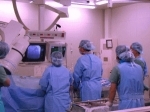by
Michael Johns, Project Manager | July 28, 2006

Catheters are the most common
source of hospital blood infections
An education and retraining program that previously reduced catheter-associated infections in ICUs at Barnes-Jewish Hospital and Missouri Baptist Medical Center has been successfully exported to five other medical centers across the nation, clinicians report in the July issue of Infection Control and Hospital Epidemiology.
Scientists found the program reduced by 21 percent serious bloodstream infections associated with central venous catheters, tubes frequently inserted into major blood vessels in critical care patients. Clinicians use the large tubes to simultaneously administer multiple drugs and fluids.
Epidemiologists have identified the catheters as the most common source of hospital-acquired bloodstream infections, which include such pathogens as Staphylococcus aureus. These infections, which occur at a rate of approximately 2,000 cases per year in the United States, can lead to serious complications such as endocarditis, or infection of the heart valves, and death. But they more commonly result in increased hospital stays.



Ad Statistics
Times Displayed: 2810
Times Visited: 27 Fast-moving cardiac structures have a big impact on imaging. Fujifilm’s SCENARIA View premium performance CT brings solutions to address motion in Coronary CTA while delivering unique dose saving and workflow increasing benefits.
"The added days of hospitalization caused by these infections can result in additional attributable hospital costs in excess of $10,000 per patient," says lead author David K. Warren, M.D., assistant professor of medicine at Washington University School of Medicine in St. Louis. "That can have significant economic impact."
Warren and his colleagues' intervention begins with updating of ICU policies on catheter insertion and maintenance to align them with recent studies of the best ways to prevent catheter-associated infections. For ICU staff, they also produce brief training modules, leaflets and posters on minimizing catheter-associated infections.
"Clinicians are often very busy, and there's only so much time they can spend reviewing the latest research," Warren says. "This was a gadget-free, inexpensive way to ensure that they have the latest insights into how to prevent infections."
As an example of how research has improved methods for minimizing infection risk, Warren cites the choice between inserting catheters in the subclavian vein near the collarbone or in the femoral vein in the groin.
"A fraction of patients will always have to get femoral catheters, but in cases where an option exists, studies have shown that there's less risk of infection from catheters inserted into the subclavian vein," he notes.
Other practices that reduce incidence of infection include inserting the catheters with sterile techniques and equipment similar to those used in surgery and ensuring that dressings on insertion sites are regularly checked for tightness and cleanliness and changed when necessary.

